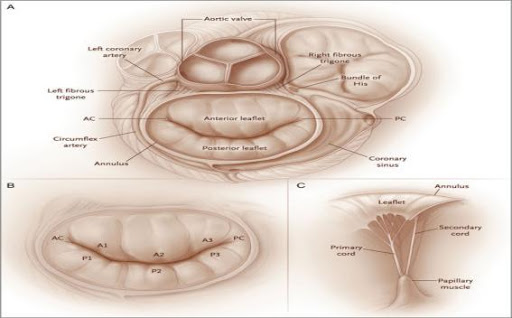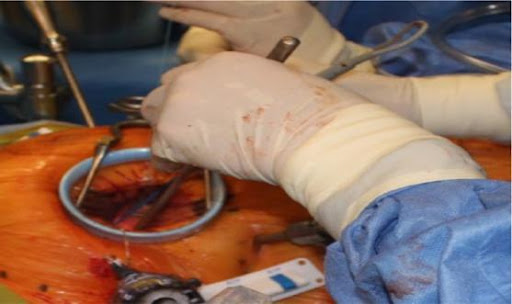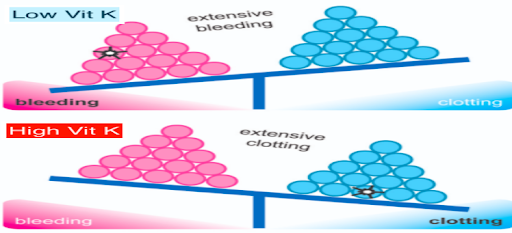Mahalakshmi Murugesan
Dietitian, Kauvery Heartcity, Trichy, India
Correspondence: dietary.khc@kauvery.in
Role of diet in mitral valve replacement: A case presentation
Abstract
Valve replacement is a surgical procedure. By this procedure, the morbidity and mortality from Valvular Heart Disease are significantly reduced (1-3%). If the person continues with the problem, it may lead to death. Depending on the patient, either a biological or mechanical valve can be implanted. After replacement, the patient needs to take anticoagulants for life. Acitrom is such a blood-thinning medication. For a patient who is on Acitrom, a Vitamin K restricted diet is prescribed.
Background
An open mitral valve replacement is a surgery to replace a poorly working mitral valve with an artificial valve. The mitral valve is one of the heart’s four valves. The mitral valve lies between the left atrium and the left ventricle.


The rapid development, favorable impact, and simplification of durable mitral valve repair techniques redefined the modern role of mitral valve replacement. The significant decrease in mitral valve replacement procedures performed in developed countries parallels modern international guidelines that strongly advocate mitral valve repair whenever possible. In addition, the increasing reports of experimental catheter-based device implantation are appealing to both clinicians and patients.
What are the risks of an Open Mitral Valve Replacement
Most people who have an open mitral valve replacement have a successful outcome, but there are certain risks. Particular risks will vary based on patient’s overall health, age, and other factors.
Infection
Bleeding
Irregular heart rhythms
Blood clots leading to stroke or heart attack
Complications from anesthesia
Continued leaking of the valve
Damage to nearby organs
Memory loss or problems with concentration
Certain factors increase the risk of complications, like:
Chronic illness
Other heart conditions
Lung problems
Increased age
Being obese
Being a smoker
Infections
Case Presentation
A 57-years-aged male was admitted to the hospital with chest pain, He was a known case of RHD (Rheumatic heart disease), with severe Mitral Stenosis, and was on treatment. On examination, patient was conscious, afebrile, pulse rate 80/min. He was admitted for Mitral valve Replacement (MVR). The patient’s anthropometric measurements were height 170 cm, weight 62 kg, BMI 21.4 kg/m2, and ideal body weight 70 kg. During the hospital stay the nutrition management was planned according to the health condition of the patient. It was followed by patient 24-h dietary recall. It showed that he consumed low fat regular diet which contains 1500 kcal, 62 g of protein and 25 g of fat per day; this diet was given at hospital for three days under the dietary guidance. He was advised for NBM (Nil by Mouth) before, and after surgery. On the fourth day, after surgery he was provided a clear liquid diet 2nd hourly 6 feeds. The next feed provided a liquid diet 2nd hourly 8 feeds. The next day we provided a semi solid diet and protein supplement. That provided additional good quality protein after surgery, and helps faster wound healing process which needs extra protein. After the surgical procedure (Replaced mechanical valve), the patient should not take more fat and Vitamin K rich food such as green leafy and green leafy vegetables as it renders the anticoagulation ineffective. He was suggested a regular low-fat and high protein diet that contains 1600 kcal, 70 g of protein and 30 g of fat.
After heart valve replacement
Recovery after mitral valve replacement surgery may vary, depending on how successful the procedure is. In addition, it depends on the ability of the patient to recover from it. Typically, a patient takes anywhere between four and eight weeks to recover from open-heart surgery for valve replacement.
But patients who undergo minimally invasive surgery for mitral valve replacement are able to recover much sooner than those who undergo open-heart surgery. Only an experienced cardiac surgeon is able to assess whether the patient is suitable for open-heart surgery or whether they should carry out minimally invasive surgery.
At the time of hospital discharge, the patient with the new biological or synthetic valve is thoroughly guided about the lifestyle changes that they need to make to be able to recover faster. Most often, the recommendations made by the surgeon concern the exercise schedule, specific dos and don’ts, wound care, medication guidelines, and the ideal timeline to resume a normal activity routine.
But most importantly, the surgeon and the cardiac rehabilitation expert tell the patient to maintain a healthy diet after the mitral valve surgery. A healthy diet plays a crucial role in the recovery of the patient following heart surgery. It not only helps them recover well but also reduces the risk of post-surgery complications and makes the body heal faster.
Diet after Heart Valve Replacement
After your valve replacement, patients need to focus on eating a healthy diet. This will help their body to heal and reduce the risk of complications and enable good recovery.
Often patients may notice that they have a poor appetite and find that food has lost its flavors. Their sense of smell may change and they may also experience a strange metallic taste in your mouth. This can be caused by the operation or the medication. It can take 3 months to fully recover. Patients should try to eat small amounts of food often.
Many studies have shown that a diet rich in fruits, vegetables, whole grains, nuts and seeds can reduce the risk of heart disease. A healthy diet provides our body with plenty of heart-protective nutrients – like vitamins, minerals, antioxidants and dietary fibre.
Dietary Guidelines
Ideal portion breakdown: The ideal daily diet should include 4 servings of whole grains, 5 servings of vegetables, and 2 servings of fruits. However, this may vary depending on the actual energy requirements of the patient.
- Sugary foods: Try to avoid sugary foods completely. These may make patients gain weight.
- Salty foods: Limit the intake of salty foods. Prepare meals with minimal salt as it will help prevent water retention and keep blood pressure normal.
- Water consumption: Intake of water as it helps maintain proper fluid balance in the body.
- Controlled fat consumption: Limit consumption of processed fats. Instead, switch to healthy fats derived from nuts, avocados, seeds, and fish oil.
- Fish consumption: Different varieties of fish such as salmon, sardines, and mackerel are rich sources of omega-3 fatty acids. These fats help protect the heart and will allow our body to heal faster than usual.
- Dairy: Switch to low-fat dairy and include it in your everyday diet.
- Protein-rich foods: Include meat or its protein-rich alternatives such as egg whites, nuts, chicken, pulses and legumes in the diet.
- Whole grain benefits: Whole grain food items such as wheat, brown rice, quinoa, couscous, barley, and rice varieties help improve energy levels and are considered good for the heart. Make sure to include a couple of servings of whole grain in daily diet.
- Millet: Millet is rich in dietary fiber, both soluble and insoluble. The insoluble fiber in millet is known as a “prebiotic,” which means it supports good bacteria in our digestive system. This type of fiber is also preventing constipation.
- Vitamin K-rich foods: It is important to consume vitamin-K-rich foods. But these should be consumed at a limit after mitral valve replacement surgery to prevent the formation of blood clots in the heart. Consult your dietitian about vitamin K-rich food items that you should completely avoid after the surgery.
Dietary precautions with Acitrom/Warfarin
Keep a check on Vitamin K. Target 90 mg daily consumption for females and 120 mg for males. Variation in intake of Vitamin K will result in a variation in INR.
The higher is vitamin K, the lower will be INR. Consuming almost the same amount of vitamin K will help your doctor to achieve a stable INR.
Try to learn food items that are very high in vit K (a few you consume frequently). A list of common food items has been given below.
Avoid items that are very high in Vitamin K (broccoli, cauliflower, cabbage, green leafy) This will lower the INR.
Learn items that contain a moderate amount of Vitamin K (pomegranate, ladyfinger there, etc.)

Conclusion
Conditional diet was prescribed and monitored for two-weeks until discharge. Post discharge dietary advice was given.
Reference
Chiu P, et al. Would evolving recommendations for mechanical mitral valve replacement further raise the bar for successful mitral valve repair? Eur J Cardiothorac Surg. 2018;54(4):622-6.
Lawrie GM. Structure, function, and dynamics of the mitral annulus: importance in mitral valve repair for myxamatous mitral valve disease. Methodist Debakey Cardiovasc J. 2010;6(1):8-14.
Vassileva CM, et al. Long-term survival of patients undergoing mitral valve repair and replacement: a longitudinal analysis of Medicare fee-forservice beneficiaries. Circulation 2013;127:1870-6.
Husted S, et al. Non-vitamin K antagonist oral anticoagulants (NOACs): no longer new or novel. Thromb Haemost. 2014;111:781-2.
Francophone Society of Oral Medicine and Oral Surgery, with the collaboration of the French Society of Cardiology. Guidelines for management of patients under antivitamin K treatment in oral surgery (2006).

M. Mahalakshmi
Dietitian
